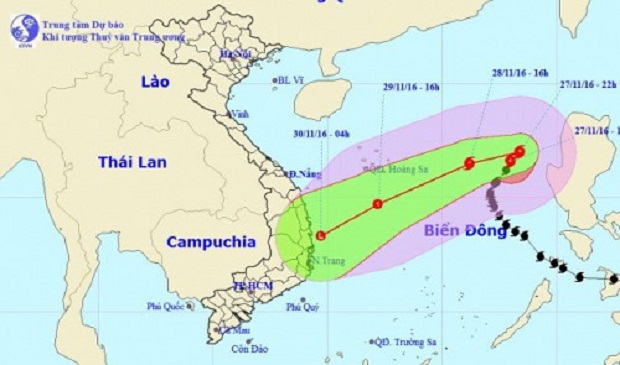Storm Tokage to bring downpours to central region
Typhoon Tokage has been forecast to head toward the south-central region of Viet Nam after entering the East Sea, bringing downpours and potential floods and landslides.
 |
| The path of the storm |
According to the National Center for Hydro-meteorological Forecasting, the tropical storm, which formed east of the Philippines on Thursday, was located about 450 kilometers southeast of Viet Nam’s Truong Sa (Spratly) archipelago on Saturday night, packing winds of 90 to 100kph.
Tokage was about 610 kilometers east of Viet Nam’s Hoang Sa (Paracel) archipelago on Sunday before traveling southwest at an average velocity of between 20 and 25kph.
Under the combined effect of the circulation of the storm and an enhanced cold front, localities from Da Nang to Khanh Hoa Province will be dampened with heavy downpours totaling 200 to 400 millimeters between November 20 and December 2.
Flood and landslides can also occur as a result of the torrential rains.
Rain is forecast to lash the provinces from Thua Thien-Hue to Nghe An afterward.
Typhoon Tokage is considered a late arrival due to the shift from the El Nino phenomenon, which has caused serious drought over the past century, to the La Nina phenomenon, the weather center said.
As a result, the stormy season in Viet Nam is anticipated to continue until January or February 2017.
According to Le Thanh Hai, Director of the National Hydro- meteorological Service, storms occurring in late November and early December are rare and often medium or weak in strength.
It is difficult to predict the accurate development of a typhoon as it depends heavily on many meteorological factors, Hai added.
Despite heading toward south-central Viet Nam, Storm Tokage could possibly weaken during its journey at sea, leaving minimal effects on the mainland, the expert continued.
Viet Nam receives an average of 10 to 12 storms and tropical depressions a year, Hai said, adding that the country could be storm-free in such year as 1976 or have as many as 19 typhoons like in 2013.
(Source: Tuoitrenew)